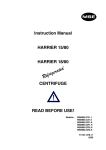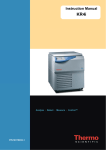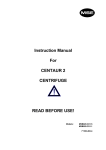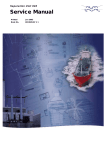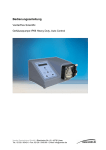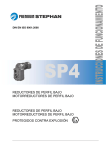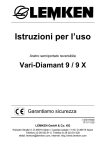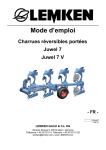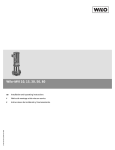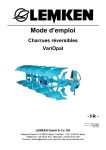Download Falcon_6300 Service Manual
Transcript
Instruction Manual FOR THE FALCON 6/300 CENTRIFUGE READ BEFORE USE! Models MSB300.CR3.I MSB300.CR4.I SMAMSB.3R1.9 ISSUE 0 9804 MSE (UK) LTD Health and Safety at Work MSE (UK) Ltd is required under the Health and Safety at Work Act, 1974 and other UK legislation as designers, manufacturers, suppliers and importers of articles for use at work to ensure that, as far as is reasonably practicable, articles which we design, produce, supply or import are safe and without risk to health. We are required to provide information on the safety and handling precautions to be observed when installing, operating, maintaining and servicing our products. Such advice is contained in this manual. We are also obliged to update this information should circumstances change and to operate a system to this end. We should also like to point out, however that you as users have an important responsibility in the provision and maintenance of safe working practices and conditions. Accordingly, we draw the following matters to your attention: 1. This apparatus should only be used as intended and within its design parameters by suitably qualified and trained personnel who have read and understood the relevant sections of this manual. 2. This manual should be readily available to such personnel at all times. 3. In addition to that which is written in the manual, normal common-sense safety precautions must be taken at all times to avoid the possibility of accidents. Particular care is required when working with apparatus at high temperature or pressure. 4. Installation, maintenance, repairs and servicing should only be carried out by an MSE (UK) Ltd approved engineer, and connection to electrical supplies should only be carried out by suitably trained personnel. TECHNICAL SUPPORT, WARRANTY SERVICE AND MAINTENANCE UK customers; if you are in any doubt whatsoever regarding the correct use of this apparatus, or if you require any technical data or assistance, please contact the MSE (UK) Ltd Technical Support Department at: MSE (UK) LTD Worsley Bridge Road Lower Sydenham London, SE26 5AZ Telephone Fax E-mail: Web Page: +44 (0) 870 609 4097 +44 (0) 208 650 8408 [email protected] www.mseuk.co.uk OVERSEAS CUSTOMERS: Should contact their local MSE (UK) Ltd distributor, details can be found on our website. ELECTRICITY SUPPLIES: Voltage and frequency MSE (UK) Ltd electrical apparatus is offered and labelled for one, or for a choice of two or more voltage ranges and, where necessary, different frequencies of mains supply. MSE (UK) Ltd does not accept any responsibility for the operation of any such apparatus should it be connected to electricity supplies which are normally outside, or vary outside, the stated voltage and frequency values for which it is designed, nor for any consequential loss, damage or injury, howsoever caused. Read This Before Use! Thank you for buying a MSE (UK) Ltd Falcon 6/300 Centrifuge. Please read this operating manual before using your centrifuge; it will provide you and your colleagues with useful information on all aspects of the equipment. As our customer, we should like to ensure that you are totally satisfied at all times. Do not hesitate to contact us. Your views are very important to us. MSE (UK) Ltd PRODUCT WARRANTY Terms and Conditions We hope that you do not have the need to use the extensive warranty cover that MSE (UK) Ltd extends to you. However should you have a problem, our prompt response is greatly helped if you have filled in and posted the pre-paid Warranty Registration Card supplied with your new equipment. MSE (UK) Ltd gives a one-year warranty from the date of delivery. During this period, component parts proven to be defective in materials or workmanship will be repaired or replaced at our expense. Installation, commissioning and calibration are not covered by this warranty agreement. The MSE (UK) Ltd approved service agent must be contacted for warranty determination and direction prior to any work being carried out. These warranties are only applicable to new products and not second hand nor refurbished products even if repaired by MSE (UK) Ltd. Any such products are covered by separate warranty terms and conditions which will be made available on request. Replacement or repair of component parts or equipment under this warranty shall not extend the warranty to either the equipment or the component part beyond the original one year warranty period unless agreed in writing by MSE (UK) Ltd. The above warranties are extended to the original purchaser upon full invoice payment. A purchase receipt or other proof of purchase may be required before warranty service will be performed. These warranties only cover failures due to defective workmanship which occur during the normal operation of the product by the original purchaser, and not failures which result from accident, misuse, abuse, neglect, mishandling, misapplication, alteration, faulty installation, electrical power fluctuations, dust, or other environmental extremes, modification or service other than by an approved service agent or following the written authority of the manufacturer, or damage that is attributable to acts of God. Expendable items such as motor brushes, door seals, lid seals, "O" rings or lamps are excluded. MSE (UK) Ltd, or its approved service agent, reserves the right to repair defective equipment on the premises of the customer, or at a service station, at the sole discretion of MSE (UK) Ltd or their approved agent. In the event of return to an approved service centre the customer is responsible for the safe packaging of the instrument and notification to the service centre. Neither MSE (UK) Ltd nor its agents are responsible for any damage occurring during shipment. Specification and Material Changes:- MSE (UK) Ltd reserves the right to supply our latest and improved models at time of shipment. Taxes:- The prices quoted do not include any taxes imposed by the State or Country in which the purchase was made. Installation:- Installation of all equipment shall be by, and at the expense of the purchaser unless stated otherwise. Access to the site, and the provision of required utilities e.g. Power, water and drainage to suitable connections, will be the responsibility of the purchaser, and at the purchaser's expense. Limitation of liability:- In no event, whether as a result of breach of contract or warranty, shall MSE (UK) Ltd be liable for any consequential or incidental damages including, but not limited to, loss of profit or revenues, loss of use of the equipment or any associated equipment, down time costs, costs of substitute equipment, costs of labour, costs due to delays or claims of purchaser's own customers for such damages. The purchaser agrees to indemnify MSE (UK) Ltd and to hold them harmless from any and all liability, claims, demands, actions, suits, expenses or costs, including attorney's fees relating to such consequential or incidental damages. All expressed and implied warranties, including the warranties of merchantable quality and fitness for a particular purpose, are limited to the application period of one year. Validity:- Legal rights vary from country to country and states within countries, so some or all of the exclusions or limitations listed above may not apply, but if any part of these conditions shall be found to be unenforceable it shall not affect the validity or enforceability of the remainder of the conditions. ELECTRICITY SUPPLY Before connecting this apparatus to the electricity supply, check the information given on the rating plate and ensure that; A) Your supply is single phase a/c (alternating current) of the stated frequency with neutral nominally at earth potential. B) Your supply voltage is within the stated range. C) The current rating is within the capacity of your outlet. D) Your plug or electricity supply circuit is fitted with a suitable fuse. Fuse rating 110v-120v Not applicable WARNING! This apparatus must be earthed. The wires in the mains lead are coloured in accordance with the following code; Live Neutral Earth Black white Green Connect the wires to a non-reversible 3-pin plug as follows:Green and Yellow to terminal marked E (Earth), G (Ground), coloured Green or Green and Yellow or marked with the Earth symbol. White wire to terminal marked N (Neutral) or Common. Black wire to terminal marked L (Live) or Phase. IMPORTANT Consult an electrician if in any doubt or if your supply system has any of the following: No earth A colour code different from above Reversible plugs Supply and return leads that are both above earth potential. NOTE: Always switch off at the socket outlet before removing plug. If no switch then ensure fingers do not touch plug pins within 2 seconds of plug removal. CONTENTS 6 1. INTRODUCTION TO YOUR CENTRIFUGE ............................................................ 8 2. GENERAL DESCRIPTION .................................................................................... 13 2.1 Centrifuge Specification ....................................................................... 14 3. INSTALLATION ..................................................................................................... 15 3.1 3.2 3.3 Connecting the power supply .......................................................... 16 Centrifuge restraint ........................................................................... 16 Accessories supplied with each centrifuge .................................... 16 4. THE CONTROL PANEL ........................................................................................ 17 4.1 4.2 Set Keys ............................................................................................. 19 Operation Keys.................................................................................. 20 5. OPERATION .......................................................................................................... 22 5.1 5.2 5.3 5.4 5.5 5.6 5.7 5.8 5.9 5.10 5.11 5.12 5.13 Setting run value ............................................................................... 23 Run procedure................................................................................... 23 Examination of set values ................................................................ 24 Changing set values ......................................................................... 24 Changing from time to time hold ..................................................... 24 Changing between SPEED and RCF modes ................................... 24 Precool facility................................................................................... 24 Programmes ...................................................................................... 25 Saving a programme ......................................................................... 25 Recalling a Stored Programme ........................................................ 26 Stop procedure.................................................................................. 26 Power failure...................................................................................... 25 Opening lid during power failure ..................................................... 26 6. PROGRAMMING EXAMPLES .............................................................................. 27 6.1 6.2 How to enter a new program ............................................................ 27 How to copy an existing program .................................................... 29 7. EXPLANATION OF ERROR MESSAGES ........................................................... 29 7.1 7.2 Critical System Errors ...................................................................... 29 Uncritical System Errors .................................................................. 32 CONTENTS 7 8. ROTORS ................................................................................................................ 36 8.1 8.2 8.3 8.4 8.5 8.6 8.7 8.8 8.9 8.10 Installation of Rotor .......................................................................... 36 Removal of Rotor .............................................................................. 36 Loading the Rotor ............................................................................. 36 Balancing the rotor ........................................................................... 36 Critical Speeds .................................................................................. 37 Materials with specific gravity in excess of 1.2 .............................. 37 Spillages ............................................................................................ 37 Corrosive materials........................................................................... 37 Infective samples .............................................................................. 38 Servicing ............................................................................................ 38 9. ROTOR AND ACCESSORY TABLES .................................................................. 39 9.1 9.2 Table 1 Swing-out rotors .................................................................. 40 Table 2 Angle rotors ......................................................................... 42 10. MAINTENANCE ..................................................................................................... 44 10.1 10.2 10.3 10.4 10.5 10.6 10.7 10.8 10.9 Resetting the Thermal Fuse ............................................................. 44 Cleaning ............................................................................................. 44 Disinfecting........................................................................................ 44 Drive shaft.......................................................................................... 44 Rotors and buckets. .......................................................................... 45 O-Rings. ............................................................................................. 45 Sterilisation........................................................................................ 45 Lid seal. .............................................................................................. 45 Detection of Corrosion ..................................................................... 45 11. SERVICE INSTRUCTIONS ................................................................................... 46 ILLUSTRATIONS Figure 1 ............................................................................................................................................... 11 Figure 2 ............................................................................................................................................... 12 Figure 3 ............................................................................................................................................... 13 Figure 4 Recommended clearances ...................................................................................................... 16 Figure 5 Suggested Restraint System ......................................................................................... 17 Figure 6 Main Control Panel Refrigerated................................................................................... 18 CONTENTS 8 Figure 7 Main Control Panel Air Cooled ...................................................................................... 18 INTRODUCTION TO YOUR CENTRIFUGE 9 1. INTRODUCTION TO YOUR CENTRIFUGE The FALCON 6/300 performance bench top centrifuge joins the well established range of MSE centrifuges. The MSE range now consists of MICRO-CENTAUR PLUS KESTREL HAWK 15/05 REFRIGERATED CENTAUR 2 HARRIER 15/80 HARRIER 18/80 REFRIGERATED HARRIER PLUS CELLSEP SONIPREP PLUS The entire MSE range of centrifuges has been designed to meet the present and future demands of routine research laboratories. A comprehensive range of rotors and accessories are available to accommodate the most commonly used centrifuge tubes and bottles. In the FALCON 6/300 MSE have utilised the best of current technology to produce the most advanced, safe and reliable instrument possible. Advanced design features include:• • • • • • • • • • • • • INTELLIGENT MICROPROCESSOR CONTROL LED DISPLAY / TACTILE CONTROL PANEL INVERTER CONTROLLED BRUSHLESS MOTOR AUTOMATIC ROTOR IDENTIFICATION SYSTEM LAST RUN RECALL OVERSPEED PROTECTION FULL LID INTERLOCK IMBALANCE MONITOR SELF DIAGNOSTIC DISPLAY TEMPERATURE CONTROL SIMPLE TO USE EASY SERVICING KEY PAD LOCK INTRODUCTION TO YOUR CENTRIFUGE • PROGRAMMABLE RUN • *REFRIGERATION • *PRECOOL FACILITY 10 *Falcon 6/300 refrigerated only INTRODUCTION TO YOUR CENTRIFUGE Figure 1 Front view of Falcon 6/300 Refrigerated 11 INTRODUCTION TO YOUR CENTRIFUGE Figure 2 Front view of Falcon 6/300 Air cooled 12 INTRODUCTION TO YOUR CENTRIFUGE Figure 3 Rear view of Falcon 6/300 13 GENERAL DESCRIPTION 14 2. GENERAL DESCRIPTION The Falcon 6/300 is a compact, large capacity, bench-top centrifuge with brushless motor, and incorporates microprocessor control, the functions of which are programmable from the key pad on the display panel. In the event of a malfunction a diagnostic indication will be displayed and the rotor is automatically allowed to come to rest. This unit complies with: EMC – Emissions Standard EN 50081-1 Immunity Standard EN 50082-1 USA FCC Part 15 Canada CSA 108.8M Designed for CSA approval to the following standards: CAN/CSA CAN/CSA C22.2 NO. 1010.1-92 C22.2 NO. 1010.2.020-94 Also incorporated is a small window in the lid for independent speed sensing using optically coupled tachometer. GENERAL DESCRIPTION 15 2.1 Centrifuge Specification Refrigerated Power supply options Power consumption at full load (Acceleration power shown in brackets) 120v 60Hz single phase Non Refrigerated 120v 60Hz single phase 120v - 2100 watts (2400 watts) 120v - 1500 watts (1800 watts) Time DISPLAY/RANGE 0 - 59 minutes 59 seconds 1 hour - 99 hours 59 minutes or Time Hold 0 - 59 minutes 59 seconds 1 hour - 99 hours 59 minutes or Time Hold Timing Accuracy 0.1 second 0.1 second Speed range up to 6,000 rpm up to 6,000 rpm Speed control accuracy ± 10 rpm ± 10 rpm Speed DISPLAY ± 20 rpm ± 20 rpm Speed SETTING increments 1 rpm 1 rpm RCF range up to 7,194g up to 6,030g RCF SETTING increments 1g 1g Temp range 0 to 40°C* _ Temp accuracy ± 2°C _ Precool -9 to ambient _ Acceleration rates 10 off 10 off Brake rates 10 off 10 off Dimensions Height 433 mm Width 826 mm Depth 600 mm (not including mains cable) Weight 146 kg Height 433 mm Width 826 mm Depth 600 mm (not including mains cable) Weight 121 kg Standard operating conditions Atmospheric pressure 950-1015 mbar (13.78 - 14.71 psi) Ambient temperature +10°C to +30°C Max. operating temperature +35°C Humidity up to 70% RH non condensing Atmospheric pressure 950-1015 mbar (13.78 - 14.71 psi) Ambient temperature +10°C to +30°C Max. operating temperature +35°C Humidity up to 70% RH non condensing * Selectable range is dependent on rotor speed and ambient temperature. With the 4 x 750ml windshield the maximum speed at which the temperature is controllable across the entire range is 5300 rpm. INSTALLATION 16 3. INSTALLATION In order to install the Falcon 6/300 these procedures should be followed. Remove the centrifuge from its packaging and place it on a rigid, level surface. DO NOT LIFT THE CENTRIFUGE BY THE LID. The location of the keyboard, display, air inlet, lid lock access hole, and the release handle are shown in Figures 1 and 2 which are on pages 10 and 12. The location of the serial number label, power switch and fuses are shown in Figure 3 on page 12. IMPORTANT: THE ROTOR MUST NOT BE FITTED WHEN MOVING THE CENTRIFUGE OR DURING TRANSIT. Check that the available power supply corresponds to that stated on the rating plate located at the rear of the instrument. If the suggested restraint system (see “Centrifuge restraint” section 17) is not used to secure the centrifuge on the bench then, it is the recommendation of CAN/CSA C22.2 No. 1010.2.010-94 that a clearance of 300 mm is allowed around the base of the centrifuge when in the final operating position. NOTE: Laboratory management procedures should require that no person or any hazardous materials are within a 300mm boundary while the centrifuge is operating. Figure 4 Recommended clearances Note: 75mm if solid surface (i.e. wall) otherwise 300mm INSTALLATION 17 3.1 Connecting the power supply 120v centrifuge - supplied with fitted plug. 3.2 Centrifuge restraint A suggested restraint system, part number SG.66500.1214, which secures the centrifuge to a sound work surface, is shown in Figure 5 below. It consists of 4 anchor brackets, positioned at each corner of the centrifuge base, which are bolted or screwed to the work surface. Figure 5 Suggested Restraint System 3.3 Accessories supplied with each centrifuge Description Quantity Emergency over-ride key 1 Guarantee card 120v/230v 1 Operating manual 1 Rotor spanner 1 Part No. 76600.004 71100.958 71100.1408 96500.384AD THE CONTROL PANEL 18 4. THE CONTROL PANEL The keypad has keys for setting variables, entering numbers and initiating functions. The main control panel keys are itemised below: 1.Set Speed 2.Set Temperature 3.Set Time 4.Set Acceleration Rate 5.Set Brake Rate 6.Display RCF 7.Precool 8.Time Hold 9.Start 10.Stop 11.Program Copy 12.Program Recall 13.Cancel Entry 14.Special Key Functions 15.Numeric Keys 0 to 9 16.Acceleration Display 17.Brake Rate Display 18.Status Display 19.Program Number Display 20.Time Hold In Progress Indicator 21.Speed/RCF Display 22.Temperature Display 23.Time Display Figure 6 Main Control Panel Refrigerated Figure 7 Main Control Panel Air Cooled THE CONTROL PANEL 19 The function of each key on the main control panel and their associated displays are described on the following pages: 4.1 Set Keys The set function keys are used to change the set values of speed, RCF, temperature, time, acceleration rate and brake rate. The set keys all work in the same manner. When the set key is pressed the set mode for that variable is entered and the appropriate display will go blank except for a flashing underscore in the least significant digit. The required value must then be entered using the number keys which will replace the underscore and scroll right to left as each digit is entered. The number will continue to flash until the set key is pressed again to finalise the change. The parameters and displays that can be changed by the set keys are described below. NOTE: Set keys have to be pressed again to set. Set Speed The speed is displayed on a five digit display showing rotor speed in revolutions per minute to ±10 rev/min. This display will show the set speed when the rotor is stationary and the actual speed when the rotor is running. If the set speed key is pressed during a run it will display the set speed for 5 seconds then automatically revert back to the actual speed. Set Temperature The temperature is displayed on a two digit display showing the bowl temperature in degrees centigrade over a range of -9°C to +40°C. If the set temperature key is pressed when the refrigeration process is on it will display the set temperature for 5 seconds then automatically revert back to the actual temperature. Set Time When the machine is running the time is displayed on a four digit display showing the time in either hours and minutes, when the time to be displayed is greater than, or equal to 1 hour, or minutes and seconds when the time to be THE CONTROL PANEL 20 displayed is less than an hour. When the machine is in stationary mode the time display will be hours: minutes. Set RCF The RCF is displayed on a five digit display, showing the set value when the rotor is stationery, and the actual value when the rotor is running. If the set RCF key is pressed during a run it will display the set RCF value for 5 seconds and then automatically revert back to the actual RCF value. The actual value can only be displayed when the rotor has been identified which is during a run when the speed is greater than 250 rev/min. Set Acceleration and Brake Rate There are two single digit displays one for the acceleration rate and one for the brake rate. The available rates are 0 to 9. 4.2 Operation Keys The operation keys are those used to make the unit perform one of the following functions: - Precool, Time hold, Start, Stop, Program Copy, Program recall, Cancel entry. The individual functions of the operation keys and their associated displays are described below:Precool The precool key turns on the refrigeration when the rotor is stationary so that the bowl can be brought to the set temperature before a run. Time hold The time hold key puts the unit into time hold mode when the rotor can be started and will run until the operator presses the stop button. The time hold indicator will illuminate to show this mode is active. The time display will count up from zero. Start THE CONTROL PANEL 21 The start key is used to start a run. Stop The stop key is used to stop a run, or truncate and save a program. Program Copy An existing program can be copied from one program number to another by pressing the copy program key followed by the new program number where you would like to put the copy. Program Recall The program recall function is used to call up an existing program for use. When the key is pressed the program display goes blank with a flashing underscore in the least significant digit. Press the program number required, and then press again to enter the program. Cancel Entry The cancel entry key is used to cancel an error, mute the bleeper or clear a display in the set mode so that a new value can be entered. THE CONTROL PANEL 22 Special Function Keys Keypad Inhibit Pressing the decimal point followed by the 3 digit number code 1,2,3 will inhibit all keypad functions with the exception of STOP when the rotor is running, and PROG RECALL, START and PRECOOL when the rotor is stationary. To cancel press decimal point and 1,2,3 again. Rotor Run Timer This timer keeps a record of the number of hours the rotor has been running. The time is accessed by pressing the copy key followed by the numbers 4,5 6, this will be displayed until it is cancelled by pressing and then 4 5 6 again. Status Display The Status Display is used to communicate the current state of the machine to the user. The display gives the highest priority message information at the time. The system errors have the highest priority followed by the operator errors, then the system status information. OPERATIONS 23 5. OPERATION 5.1 Setting run value Press or Enter the required value for the function selected using the numeric keypad. Repeat above until all run values required have been accepted. If a timed run is not required press The following table shows the digit display range. Max. Digits Speed Temperature Time 4 2 3 RCF Brake 4 1 Accel Programme 1 1 Allowed range 200 to 6,000 rev/min -9ºC to 40ºC 1 second to 59 minutes 59 seconds or 1 minute to 99 hours 59 minutes 10 to 7194g 0 to 9 0 (min. brake) 9 (max. brake) 0 to 9 0-49 5.2 Run procedure Ensure that the rotor is correctly loaded. Close the lid and press down firmly. Press As the drive is engaged all displays will change to ACTUAL values. At approximately 150 rev/min the microprocessor checks a signal received from the rotor which typifies its maximum speed and checks the SET speed. Should the SET speed be greater than the maximum allowed for the rotor in use the SET speed will automatically be reduced to the maximum allowed. When in RCF mode the speed check described above is still initiated after the SET RCF value has been converted to the equivalent speed value, if the SET RCF exceeds the maximum allowed it will be reduced to the maximum. OPERATIONS 24 5.3 Examination of set values All keys, with the exception of the stop key, change their mode of operation becoming active for only 5 seconds after being pressed. Press function required, the associated display changes from ACTUAL to SET values for the time period and then reverts to ACTUAL. 5.4 Changing set values Press function requiring new value. When at rest the display will change to SET, as above. Input new value, the display will then show the new data as it is entered. When the allowed number of digits are entered (see the digit display range table on the previous page), and set mode is left, the data entered is checked for validity and if valid becomes the new SET value, whilst the display reverts to ACTUAL. 5.5 Changing from time to time hold When at rest press and the time hold LED will come on. toggles the hold LED in stationary mode. Pressing 5.6 Changing between SPEED and RCF modes When the rotor is stationary press the function key associated with the required mode. Enter new data, if the data is valid the status display will show the relevant mode (RPM or RCF), and the centrifuge will begin controlling to the new mode set value. In addition to the message on the status display a single LED will illuminate in the lower right corner of the SPEED/RCF display when in RCF mode. 5.7 Precool facility To precool a rotor and/or the rotor chamber prior to a centrifuge run proceed as follows: 1. Place required rotor on the drive spindle and tighten the spindle nut 2. Close the centrifuge lid 3. Select the required temperature as for setting run values Press the status will show the word PRECOOL to indicate that precooling is in progress. To terminate the precool facility: Press All functions are active and can be used as under setting run values whilst precool is initiated. OPERATIONS If 25 is pressed the centrifuge will respond as for normal operation. 5.8 Programmes A programme is defined by the values required for each of the control functions provided on the centrifuge and provision is made to store 50 different programmes numbered 0 to 49 inclusive. All programmes (0-49) are retained when the power is off. Programmes can only be saved or recalled when the drive spindle is stationary, the lid unlocked, and the mains switch on. It is recommended that the user maintains a log of the programmes stored and their use for each centrifuge. 5.9 Saving a programme If a programme log is kept for the centrifuge assign the next available programme number to the programme to be saved and enter the run parameters in the log. Press the programme display will blank and then show a prompt cursor, enter the assigned programme number using the numeric data key. All current data is stored to that program number overwriting existing values. OPERATIONS 26 5.10 Recalling a Stored Programme To recall a previously saved programme Press the programme display will blank then show a prompt cursor, enter the required programme number. The programme run parameters will now be displayed. 5.11 Stop procedure When the programme is completed the rotor will automatically come to rest and the lid lock will be released. Operation of the stop button at any time will override the programme and the rotor will come to rest. 5.12 Power failure If the mains power to the centrifuge is interrupted during a run the rotor will coast to a stop and the lid will remain locked. The centrifuge will remain in this condition and “POWFAIL” will appear on the status display, (see Critical System Errors). 5.13 Opening lid during power failure An electrical interlock prevents the lid being opened while the rotor is turning or when the power is disconnected. If access to the rotor is required during power failure use of the lid lock release key is necessary, this is supplied with the accessories. Insert the key into the small hole on the top of the lid, near the front. Move the point towards the rear, a slight spring pressure will be felt and the lid lock mechanism will be actuated. Press the lid actuator to the right and open the lid. The lid is counterbalanced to remain open. WARNING: THE ROTOR MAY STILL BE ROTATING PROGRAMMING EXAMPLE 27 6. PROGRAMMING EXAMPLES 6.1 How to enter a new program This example will show step by step how to enter a new program. The program sequence to be entered will make the rotor run up to a speed of 1000 rpm with an acceleration rate of 5. It will stay at 1000 rpm until the 5 minutes have elapsed, and then stop with a brake rate of 8. The graph illustrates the program sequence which in the example will be saved as program number 11. SPEED RPM 3000 ACCELERATION RATE 5 BRAKE RATE 8 1000 5 MINS 10 MINS TIME 1. Select the program memory location where the program will be saved. • Press program recall. • Enter the program number 1,1 at the flashing underscore. • Press program recall to finish program location selection. 2. Enter the settings for the speed, temperature, time at speed and acceleration rate. • Press the set speed key • Enter a speed of 1,0,0,0 • Press the set speed key PROGRAMMING EXAMPLE • Enter a temperature of 4 • Press set temperature • Press set time • Enter 0 hours • Press set time • Enter 5 minutes • Press set time • Press set accel • Enter accel rate 5 • Press set acceleration 28 PROGRAMMING EXAMPLE 29 • Press set brake • Enter 8 for the brake rate • Press set brake Note: The timer starts counting down from set, or up from 00:00 in hold, when START RUN is pressed. 6.2 How to copy an existing program This example will copy program 11, the program that was entered in the previous example, to program 22. 1. Recall program 11 to make it the currently selected program. • Press program recall. • Enter the program number 1,1 at the flashing underscore. • Press program recall to display required program. 2. Copy the current program to program 22. • Press program copy. • Enter the program number 2,2 at the flashing underscore. • Press program copy to overwrite program 22 with program 11. EXPLANATION OF ERRORS 30 7. EXPLANATION OF ERROR MESSAGES 7.1 Critical System Errors Note 1: All critical system errors will generate an alarm bleep, and cause the lid to remain locked when the rotor is stationary. The error can only be cancelled when the machine is stationary and the lid has been opened using the manual lid lock override procedure. Note 2: The alarm bleeper can be muted at any time using the cancel key. ERROR MESSAGE EXPLANATION BAD STOP During brake mode the rotor has stopped prematurely before the unit has finished the run. BAD CHKS The communications between the control pad and the inverter have been corrupted. The error will be generated when the lid is left open for more than four minutes and precool is in operation. The rotor will stop. Cancel the error and call the service personnel. The alarm will be initiated by the refrigeration control. Close the lid and cancel the alarm. The rotor speed detector has malfunctioned. The rotor will coast to stop. Wait until the rotor has stopped then use the emergency lid open procedure (see section 5.13). LID OPEN NO TACHO EFFECT ON MACHINE OPERATION The unit will give an alarm. OPERATOR ACTION Cancel the error and call service personnel. EXPLANATION OF ERRORS 31 Critical System Errors Continued ERROR MESSAGE SPEED + EXPLANATION EFFECT ON MACHINE OPERATION The rotor speed is greater than 300 The rotor will stop. rpm above where the controller thinks it should be which is potentially an over speed condition. OPERATOR ACTION Disconnect the power supply and do not use the centrifuge further until checked by service personnel. SPEED - The rotor has not yet reached set speed. The rotor will stop. Call service personnel. REVERSE After the rotor identification, at 250 rev/min, the rotor appeared to be rotating in the wrong direction. The rotor will stop. Call the service personnel. SER TOUT The communications between the control pod and the inverter have been corrupted. The rotor will stop. Call the service personnel. EXPLANATION OF ERRORS 32 Critical System Errors Continued ERROR MESSAGE EXPLANATION UNLOCKED OR LID BAR The lid solenoid is not engaged hence the lid is not properly locked. Micro switch failure. PWR FAIL The run has been interrupted by a mains supply failure. EFFECT ON MACHINE OPERATION If the rotor is running it will coast to a stop with an alarm. If an attempt is made to restart with the lid unlocked it will give an alarm. The rotor will stop. OPERATOR ACTION If the rotor was running when the error occurred wait until the rotor is stationary before using the emergency lid open procedure and call the service personnel. If the error happened when stationary, cancel the alarm and press lid firmly down, and continue. If alarm sounds again call service personnel. Cancel the error and restart the run if it is appropriate for the samples. EXPLANATION OF ERRORS 33 7.2 Uncritical System Errors Note 1: These errors can be cancelled when the machine is stationary without the need to open the lid. ERROR MESSAGE EXPLANATION EFFECT ON MACHINE OPERATION The rotor will stop OPERATOR ACTION BAD ID The rotor has not been identified before the speed has reached 250 rev/min OR Rotor has been identified as one which cannot be used in this centrifuge. SET > MAX The set speed for the current step was greater than the maximum allowed rotor speed. The rotor will only achieve allowed maximum speed and the run will be completed. Change the offending set speed to less than the allowed maximum rotor speed. TEMP LOW The bowl temperature is less than 6°C below set temperature due to possible temperature control failure Excessively low bowl temperature might be reached Switch the unit off and call the service personnel Wait until the rotor is stationary then open the lid and cancel the error Remove rotor and clean drive head. Clean and inspect rotor bore and underside of rotor. Check magnets are not missing or damaged. Check circuit function by fitting a different rotor. EXPLANATION OF ERRORS 34 Uncritical System Errors Continued ERROR MESSAGE EXPLANATION EFFECT ON MACHINE OPERATION Excessively high bowl temperature will occur if the rotor is running. TEMP HI The bowl temperature is more than 6°C above set temperature due to refrigeration system failure. OVER 45° The bowl temperature has exceeded 45°, due to refrigeration system failure. IMB HIGH This only occurs when the machine is stationary and means the automatic imbalance test circuit has detected a fault with the imbalance detector. It can also occur if the rotor is knocked accidentally or there is a mains fluctuation. Cancel the alarm. If the alarm persists call the service personnel. IMB LOW This only occurs when the rotor is stationary and means the automatic imbalance test circuit has detected a fault with the imbalance detector. It can also occur if the rotor is knocked accidentally or there is an excessive mains fluctuation. Cancel the alarm. If the alarm persists call the service personnel. Machine will come to a stop. OPERATOR ACTION Switch the unit off and call the service personnel. Switch the unit off and call the service personnel. EXPLANATION OF ERRORS 35 Uncritical System Errors Continued ERROR MESSAGE EXPLANATION EFFECT ON MACHINE OPERATION Saved data may be corrupted. OPERATOR ACTION BAD MEM The new data just entered has not been saved correctly in the controllers permanent memory. BAD RCF The set RCF value is greater than the max. allowed RCF. The motor will not start. Enter a smaller value for the set RCF. HOTMOTOR The drive motor windings have overheated. The motor thermal cut-out has triggered. The rotor will stop. Check the air inlet and outlet for blockages, if none are found call the service personnel. Cancel the error and try again. If the error persists call the service personnel. ROTORS 36 8. ROTORS 8.1 Installation of Rotor Before fitting a rotor to the centrifuge ensure that the drive head is clean. Check that the rotor is clean and pay particular attention to the pivot pins of swing-out rotors and the pockets in angle rotors. Locate the rotor on the drive shaft and ensuring that the correct spindle nut for the rotor in use is employed tighten nut using the spanner provided. 8.2 Removal of Rotor Open the centrifuge lid to gain access, then set the power switch to OFF. Lift out all rotor accessories, e.g. buckets. Remove the spindle nut and grip the rotor. Gently ease the rotor upwards clear of the spindle. Note: Do not attempt to loosen the rotor by tapping on the drive head. 8.3 Loading the Rotor Buckets, cups and trunnions are supplied as matched, balanced assemblies. It is important that all components should be stored and used together. The rotor must always be used with a full complement of buckets, but it is not necessary for all buckets to be loaded, provided that the loads are placed symmetrically around the rotor. When using the angle rotors ensure all the pockets are clean before fitting the buckets. When using the swing out rotor ensure that the buckets swing freely about their pivots. If datum marks exist on the wind shielded lids, ensure that these marks are aligned with the corresponding datum on the windshield body or rotor hub. DO NOT RUN WINDSHIELDED ROTORS WITHOUT THEIR COVERS IN PLACE. FAILURE TO COMPLY WITH THIS REQUIREMENT COULD RESULT IN SERIOUS DAMAGE TO THE CENTRIFUGE DRIVE. CARE MUST BE TAKEN TO PREVENT DISTORTION OF WINDSHIELDED ROTORS. LIFT THEM BY GRASPING THE ARMS OF ROTOR SPIDER AND NOT BY THE WINDSHIELD. If using a swing-out rotor, check that all cups/buckets are correctly located on their pivot pins by ensuring that they swing freely. 8.4 Balancing the rotor The loads should be reasonably balanced, which in most cases means equalising the liquid levels by eye. In the swing out rotor do not exceed 5 grams between loads when fully or partially loaded. When loading trunnion carriers the following procedure should be followed: 1) Weight group the buckets to within 5g. 2) Weight group the trunnion block and buckets as an assembly to within 5g. FAILURE TO LOAD THE ROTOR CAREFULLY WILL TRIP THE OUT-OFBALANCE SENSOR, CAUSING THE CENTRIFUGE TO STOP. ROTORS 37 In this case the display will show “M/C has imbalanced”. An unbalanced rotor will make the centrifuge noisy in operation. 8.5 Critical Speeds Like all centrifuges the Falcon 6/300 has a critical speed associated with each rotor. It is therefore recommended that continuous running between 400 - 700 rev/min is avoided. 8.6 Materials with specific gravity in excess of 1.2 Maximum speeds of rotors (see tables on following pages) are calculated on the basis of tubes filled with a sample of specific gravity 1.2. If liquids of higher specific gravity are used, the maximum speed of the rotor must be reduced according to formula: Where M = New maximum speed N = Maximum rotor speed at 1.2 specific gravity S = Specific gravity of sample 8.7 Spillages In the event of a liquid spillage the affected surfaces should be cleaned immediately. The rotor and accessories should be removed for thorough cleaning. Regular cleaning of the centrifuge is highly recommended to avoid the build up of contaminants. 8.8 Corrosive materials Where particularly corrosive materials are to be centrifuged, the samples should be placed in sealed containers and all necessary precautions observed. The following list gives examples of corrosive materials used in laboratories. • • • • Phenol/cresol/water Chloroform/isoamyl alcohol Salt solutions (especially ammonium sulphate) Solutions of ammonium hydroxide and acidic solutions e.g. hydrochloric, trichoracetic and perchloric acids. Other materials may be equally corrosive, the user is responsible for checking the characteristics of substances used. NOTE: The following materials are prohibited: Flammable or explosive materials Materials which chemically interact vigorously ROTORS 38 8.9 Infective samples Very special care is necessary when infective materials are to be centrifuged. Sealed containers should always be used. The caps should be double checked to ensure that they are not damaged and fit correctly prior to starting the centrifuge. After use containers and caps should be sterilised immediately using a non-corrosive method. NOTE: Sealed containers and related components are intended to be part of biosafety systems such as are specified in international and national biosafety guide lines, and cannot be relied on as the only means of safeguarding workers and the environment when handling pathogenic micro-organisms. 8.10 Servicing It is advisable to have this centrifuge serviced regularly by a competent engineer, preferably the manufacturer's representative, at least once per year. ROTOR AND ACCESSORIES 39 9. ROTOR AND ACCESSORY TABLES The following pages contain tables listing the rotors and accessories which are available for use with your Falcon 6/300 centrifuge. The centrifuge complies with the requirements of CAN/CSA C22.2 No. 1010.2.020-94 only when fitted with one of the rotors show in these tables. Mixed loads may be carried, providing that the two opposite buckets are carrying the same type of load. ROTOR AND ACCESSORIES 40 9.1 Table 1 Swing-out rotors ROTOR 4-place wind shielded High speed swing-out 43124-756 CUP ADAPTOR Packed sets of 4 Packed sets of 4 Bucket assy 750 ml 43551.123 Bottle with cap 750 ml 43551-124 Blood bag liners 43551-126 ROTOR CAPACITY MAX. SPEED REFRIGERA TED MAX. SPEED AIR COOLED PERMISSIBLE MAX RCF x g (Refrigerated) TUBE SIZES Dia (mm) 43155-1354 (red) 43155-134 A(green) 43155-133 5(orange) 43155-1322 (blue) 43155-136 9(yellow) 43155-152(beige) 43155-153(maroon) 43551-124A(white) 20 x 50 ml 76 x 15 ml 112 x 7 ml 148 x 5 ml 28 x 30 ml 25x50 ml 48x15 ml 4 x 750 ml 4700 4700 4700 4700 4700 4700 4700 4700 3660 3660 3660 3660 3660 3660 3600 3660 4879 4779 4655 4655 4655 4879 4779 4964 43551-1269(white) 4x98 mm 4700 3660 4964 32.0 17 13 12 28.5 32 17 Ht (mm) inc.cap 120 125 125 125 125 125 125 ROTOR AND ACCESSORIES 41 Table 1 Swing-out rotors continued ROTOR 4-place swing-out 43124-1298 CUP ADAPTOR Packed sets of 4 Packed sets of 4 Slotted cup for tissue culture bottle 43551-130 Micro-titre carrier 41159-1900 8-place swing-out 43122.105 Sealed cup 200 ml 43551-121 Bottle with cap 200 ml 43551-103 (each) 34159-3021(brown) 34159-301 7(yellow) 34159-304 0(green) 34159-303 6(grey) 34159-305 5(orange) 34159-306 A(blue) 34159-308(black) 34159-309(beige) 34159-310(maroon) ROTOR CAPACITY MAX. SPEED PERMISSIBLE MAX RCF x g TUBE SIZES Dia (mm) Ht (mm) inc.cap 4x250 ml 2500 1450 4 x carrier (max. 3 trays per carrier) 2500 1329* 8 x 100 ml 8 x 50 ml (DHSS bottle) 56 x 15 ml 32 x 10 ml (DHSS) 72 x 7 l 96 x 5 ml 56x15 ml 8x50 ml 24x15 ml 3200 3200 3200 3200 3200 3200 3200 3200 3200 2375 2375 2375 2335 2357 2375 2315 2375 2375 39.5 29 17 16.5 13 12 17 29 17 118 118 118 100 118 118 118 120 120 8 x 200 ml 3200 2370 57.7 120 *Subject to capability of trays used ROTOR AND ACCESSORIES 42 9.2 Table 2 Angle rotors ROTOR CUP Packed sets of 4 ADAPTOR Packed sets of 4 6 place universal angle 43117-605 34411-912 34411-912 34411-912 34411-912 34142-105 34144-308 34151-302 34153-302 8 x 50ml angle rotor 43117-610 Sealed Aluminium bucket 43156-603 34142-110 50ml conical tube adaptor 16 place universal angle 43114-609 34144-307 ROTOR CAPACITY 6 x 100 ml 6 x 50 ml 12 x 15 ml 30 x 7 ml 8 x 50 ml 16 x 50 ml 16 x 15 ml MAX. SPEED MAX. RCF x g TUBE SIZES Dia (mm) Ht (mm) inc.cap 6000 6000 6000 6000 5524 5108 5524 5311 42 29 17 13 125 120 118 118 6000 5635 29 120 6000 6000 5920 5720 29 17.5 110 110 ROTOR AND ACCESSORIES 43 Table 2 Angle rotors continued ROTOR 24 place universal angle 43114-608 CUP ADAPTOR ROTOR Packed sets of 4 Packed sets of 4 CAPACITY 24 x 15 ml MAX. SPEED MAX. RCF x g TUBE SIZES Dia (mm) 6000 6030 17 Ht (mm) inc.cap 108 MAINTENANCE 44 10. MAINTENANCE This section describes the basic maintenance procedures, in particular, the methods and materials used for cleaning the centrifuge, rotors and accessories. It is recommended that a regular inspection of the centrifuge is made after 1000 hours of operation or at least once per year, whichever is the sooner. This should include all rotors and accessories. Electricity at Work Regulations (1989). Portable Appliance Testing (PAT) Where applicable this centrifuge should be inspected and tested regularly in accordance with these regulations and the appropriate records kept. For Warranty Service and Maintenance please see the details given at the front of this manual. 10.1 Resetting the Thermal Fuse The Falcon unit is fitted with a thermal fuse/trip to prevent power overload. The trip is located at the rear of the unit adjacent to the mains cable and can be reset by pressing the plunger back in, towards the rear panel. Should the fuse trip immediately or again during normal use, the power supply should be disconnected and the service engineer called. 10.2 Cleaning To maintain a good appearance and to prevent dirt build-up, the casing and the inside of the bowl should be cleaned regularly using a soft cloth dampened with a neutral detergent and warm water. The keypad and display may also be cleaned in this manner, but should be wiped dry immediately. If corrosive materials are used in the centrifuge, it is especially important to clean out the centrifuge bowl thoroughly. If a major spillage occurs in the bowl, the excess liquid should be mopped out and the bowl then cleaned using a suitable cleaning agent. 10.3 Disinfecting To disinfect the centrifuge the following cleaning fluids may be used TERMINEX 2 (available from Arrow Chemicals Ltd) VIRKON (available from Antec International) These cleaning agents if used as instructed by the manufacturer should not be harmful to the centrifuge or the accessories supplied for use with it. WARNING SOLVENTS OR GRITTY CLEANERS SHOULD NEVER BE USED EXCESSIVE USE OF WATER SHOULD BE AVOIDED 10.4 Drive shaft The drive shaft should be cleaned periodically with a solvent to remove excessive grease. When clean, re-lubricate the shaft lightly with petroleum jelly. MAINTENANCE 10.5 45 Rotors and buckets. The typical environment used in centrifuging, can, over a period of time create a strength degrading effect in rotors and accessories used, also additional hazards in the form of corrosion and/or stress corrosion. These conditions can reduce the basic strength of the centrifuge component and could lead to premature failure. Simple corrosion, particularly in Aluminium, can usually be seen by the naked eye and appears in the form of pitting or white fluffy deposits on the material surface. Stress corrosion usually is more damaging than simple corrosion and is the adverse effect created by a combination of both stress and chemical reaction. The rotors and accessories should be handled with care to avoid damage. Prior to storage, all components should be protected against corrosion using MSE Rotor Spray (Cat No. 17341-1512) which is an anti-corrosion and de-waterizing agent. Washing the rotors and accessories in warm water containing mild detergent, ensuring it`s thoroughly dry, followed by spraying with MSE Rotor Protection Spray (Cat No 17341-1512) will help to prolong the life of your rotor and accessories. Always handle rotors and accessories with care to avoid damage. Buckets and cups should be stored inverted. Rotors The trunnions of the swing-out rotors must be lubricated at regular intervals to avoid the occurrence of imbalance within the assembly. Non maintenance of the trunnions can lead to the buckets swinging out in a staggered motion inducing imbalance and possible damage to samples or the centrifuge. IT IS RECCOMENDED THAT THE TRUNNIONS ARE LUBRICATED DAILY OR EVERY 8 HOURS OF OPERATIONAL USE. Before lubricating the trunnions ensure that all of the existing Molykote and any debris is fully removed - do not use abrasive cleaners or this operation. Buckets Ensure that the slots machined into the buckets are clean and lightly lubricated. • Pivot areas should be cleaned using Loctite 7063 and a soft cloth (cheesecloth). • Spray each area with lubricant spray D321R • Leave for approximately 20 to 30 minutes to dry and then polish each pivot area with a clean soft cloth Spray cleaner – Loctite 7063 (Cat. No. SG. 16200.026) Spray lubricant – Molykote D321R (Cat. No. SG. 22100.042) NOTE: Please follow spray cleaner/lubricant manufacturers recommendations during use. MAINTENANCE 46 10.6 O-Rings Ensure that the O-Rings fitted to the sealing caps and covers are lightly coated with silicone grease. Check the O-Rings regularly for cuts and abrasions, replacing as necessary but at least once a year. 10.7 Sterilisation All of the rotors, buckets and sealing caps (with O-Rings removed) may be sterilised by autoclaving at 121°C for 22 minutes. The plastic adaptors may be autoclaved at 121°C for 10 minutes. DO NOT autoclave any parts where the protective finish is scratched or damaged. If the means available for disinfection of certain microbiological agents are inadequate, the safety officer should be consulted and appropriate steps taken. 10.8 Lid/Bowl seal. Lightly coat the lid seal with French chalk occasionally and in particular after cleaning. SERVICE INSTRUCTIONS 47 11. SERVICE INSTRUCTIONS MSE (UK) Ltd is committed to giving our customers the best possible service. If your centrifuge should require service at any time please follow these procedures: All countries except UK- Contact your local MSE (UK) Ltd distributor, details can be found on our website: www.mseuk.co.uk UK only For all technical and service enquires contact: MSE (UK) Ltd Worsley Bridge Road Lower Sydenham London, SE26 5AZ Telephone +44 (0) 870 609 4097 Fax +44 (0) 208 650 8408 E-mail: [email protected] 1. Contact the repairs centre - have the model, serial number, and date of purchase and fault description available. 2. You will be given a return goods authorisation number and directions for shipping. 3. Remove all rotors, buckets and adapters. Do not ship these items - only the centrifuge. 4. Thoroughly clean and disinfect the centrifuge. 5. Fill out the attached service request form and place inside the centrifuge. 6. Pack in a protective box (preferably that in which the centrifuge was originally supplied). 7. MSE (UK) Ltd will specify the carrier to be used and will give details of how the freight is to be charged. Falcon 6/300 SERVICE REQUEST FORM Should it become necessary to have your MSE centrifuge repaired. Please take a few moments to fill out this form which will help us to ensure you receive the best and fastest service possible. Serial number :(on plate at back of unit) ........................................................................... Date purchased :- ........................................................................... Where purchased :- ........................................................................... Brief description of fault :- ........................................................................... ........................................................................... ........................................................................... Date fault first occurred :- ........................................................................... Date repair centre contacted :- ........................................................................... Authorisation number :- ........................................................................... Condition of centrifuge :- ........................................................................... Has it been disinfected? Yes / No Disinfectant used :- ........................................................................... Contact name :- ........................................................................... Address :- ........................................................................... ........................................................................... ........................................................................... Telephone Number :- ........................................................................... Signature :- ........................................................................... MSE (UK) Ltd Part Number Description 66500.993 LID LOCK ASSY M3000 60800.001 16010.009 86120.050 86210.016 88120.162 36020.027 37010.045 72100.116 72100.118 72100.119 72900.047 72900.048 78100.053 11060.410 11060.512 11070.220 11860.001 13170.200 13260.400 13260.500 13360.200 14030.009 14100.018 23400.014 72900.059 87120.073 14030.004 16010.010 TERMINATED SOLENOID MOLYKOTE PG30L PLASTICSLIP SOLENOID PLUNGER CLAMP PLATE CATCH PIN SHORT MICROSWITCH TERMINAL BLOCK SOLENOID NOSE PIN ACTUATING DISC CATCH BASEPLATE CONICAL SPRING CATCH SPRING SPRING SCREW M4 X 10 LG PAN HD SCREW M5X12 LG PAN HD M2X20 CH. HD. SCR ST. ST. PLASTITE SCREW NO 6X3/8 M2 PLAIN STST WASHER WASHER M4 S/P WASHER M5 S/P WASHER M2 S/COIL STEEL PUSH ON FIXER SPACER SIZE M5 LOCTITE SCREW LOC 222E LOCK BAR LOCK PIN PUSH-ON FIX GREASE SHELL ALBIDA RL2 UOM Quantity each each each each each each each each each each each each each each each each each each each each each each each each each each each each 1 0.001 1 1 1 1 0.17 1 1 1 1 1 1 2 1 2 2 2 2 1 2 1 1 0.001 2 2 4 0.01 UOM Quantity MSE (UK) Ltd Part number Description 61080.054 TACHO PCB ASSY 61400.030 43040.071 44010.084 TACHO LEAD ASSY HALL EFFECT SENSOR TACHO PCB 1 each each each 1 1 1 Part number MSE (UK) Ltd Description 66500.1176DA FALCON 220/240V REF 15800.002 71100.919 15400.003 13360.200 13260.800 11660.616 12260.800 23020.009 23400.012 16200.001 71100.1022 11860.013 61200.412 61500.079 61500.080 61500.081 61500.082 61500.083 61500.137 15520.039 15520.010 15400.005 46020.021 96500.719 71500.122 96500.876 75050.010 15500.257 96501.057 81170.060 23400.014 11660.625 15400.006 16200.019 16200.024 32400.028 61500.138 66500.1234 EARTH WASHER M5 RATING LABEL CABLE TIE WASHER M2 S/COIL STEEL WASHER M8 S/PROOF SCREW M6 X 16 NUT M8 FULL STEEL R404A REFRIGERANT GAS LOCTITE 601 (50 ML SIZE) LOCTITE STUDLOCK 270 BLANK LABEL - METALIZED TAPTITE M4 X 8 PAN HEAD LOW VOLTAGE CABLEFROM MM3000I IMBALANCE CABLE M3000 TACHO CABLE ASSY M3000 ROTOR I/D1 CABLE ASSY M3000 ROTOR I/D2 CABLE ASSY M3000 MAIN SWITCH TO TB CABLEFORM MAINS SWITCH LEAD ASSY. FALCON .110 X .032 RED HI TAG .110 X .02 RED F I CABLE CLAMP THERMISTOR LEAD WIRE ASSY THERMISTOR COVER PLATE-M2000R THERMISTOR COVER PLATE GASKET PCB SCREEN PLATE. M3000 GROMMET STRIP FASTON TAB FAN COWLING STAY FALCON PULLEY FALCON 6/300 LOCTITE SCREW LOC 222E SCREW M6X25 SKT HD CABLE TIE BASE LOCTITE 406 20G LOCTITE 770 PRIMER MAINS FILTER 11A 250V F4018 EARTH LEAD ASSY. FALCON R 240V 4 X 750 ROTOR 4700RPM Quantity 1 1 20 2 10 8 6 0.29 0.001 0.001 2 6 1 1 1 1 1 1 1 2 4 3 1 1 1 1 0.52 1 1 1 0.001 4 2 0.001 0.001 1 1 1 MSE (UK) Ltd Part number Description 66500.1176DA FALCON 220/240V REF 27200.003 77800.019 73300.026 73300.027 73700.106 73900.005 74030.002 74600.041 77300.184 77300.185 78100.113 78100.031 78100.050 78100.051 78100.052 71100.1046 11060.310 11060.410 11060.416 11060.420 11170.312 11160.413 11060.615 11460.612 11460.825 11560.508 11560.813 12220.501 12260.400 12260.600 BUBBLE WRAP C.120 SMALL ENAMEL YELLOW, UMBROL NO 188 D.U. BUSH 10 ID D.U. BUSH 6 ID CIRCLIP CLEVIS DRIVE BELT JB 5M1030 RUBBER BUFFER/FOOT FLARE NUT 3/8 SHORT BEND 90 EQUAL LONG ENDS TENSION SPRING TENSION SPRING COMPRESSION SPRING SPRING PIN DISC SPRING DANYO LOGO SCREW M3X10 LG PAN ND. SCREW M4 X 10 LG PAN HD. SCREW M4 X 16 LG PAN HD. SCREW M4 X 20 LG PAN HD SCREW M3 X 12L CSK HD POZI S/S SCREW M4X16L RAISED CSK S`DRIV SCREW M6 X 16 PAN HD POZI SCREW M6 X 12 LG HEX HD BOLT M8 X 25L SKT. SET SCREW M5 X 9 SCREW M8 X 25L BRASS NUT M5 NUT M4 HEX NUT M6 HEX Quantity 0.2 0.001 1 1 2 1 1 6 1 1 2 1 1 1 2 1 4 25 7 2 1 5 3 1 4 2 4 3 9 6 MSE (UK) Ltd Part number Description 66500.1176DA FALCON 220/240V REF 12360.900 12760.404 12760.605 13160.300 13160.400 13160.600 13160.800 13260.400 13260.500 13260.600 14010.328 14030.008 13170.200 14900.189 14900.281 14900.360 15400.004 15400.017 15700.212 66500.1100 61100.079 11170.410 61200.372 66500.1188DA 66500.1181 66500.1098AD 66500.1141 96500.063 96500.064 96500.964AD 96500.965AD 96500.083AD 96500.094 96500.096AD 66500.1199 66500.1197 NUT NYLOC M10 1M4 NUT RETAINER CAPTIVE NUT SPIRE M6 WASHER M3 WASHER M4 PLAIN WASHER M6 PLAIN WASHER M8 M.S. WASHER M4 S/P WASHER M5 S/P WASHER M6 INT. S/P DOWEL PIN 3MM X 16 LG PUSH ON FIXER M2 PLAIN STST WASHER WASHER 8BA S/P SCREW 8BA X 1/2″ CH. HD WASHER RETAINING CABLE TIE TIE HOLDER RING TAG M5 PCB MOUNTING ASSY M3000I MAINS CABLE ASSY M3000 SCR. CSK M4 X 10 SS TRANSFORMER ASSY/CABLEFORM FALCON FRONT PANEL ASSY REF FALCON MOTOR ASSY 240V LID TRAY ASSY M3000I 240 M3000 DIGITAL ADJ B/H` SG ASSY LEVER ASSY RH LEVER ASSY LH SIDE COVER RH ASSY PAINTED SIDE COVER LH PAINTED LID COVER SPRING POST LIFTING HANDEL ASSY REFRIGERATION SUB ASSY-FALCON ELECTRICAL SUB ASSY-FALCON Quantity 1 25 12 3 31 8 7 42 5 20 1 2 2 2 2 6 4 2 1 1 1 4 1 1 1 1 1 1 1 1 1 1 1 2 1 1 MSE (UK) Ltd Part number Description 66500.1176DA FALCON 220/240V REF 11560.606 96500.733 96501.080 96500.861AJ 96500.985AD 81140.072 86000.005 86110.136 86210.015 86230.020 88000.015 88110.060 88130.027 88820.026 31100.017 31100.014 31100.025 31200.036 31200.041 32600.095 32900.036 33040.317 36020.051 36040.067 71100.143 71100.864FB 71500.039 71800.031 71800.048 72100.428 SKT. SET SCREW M6 X 6 CONE POINTSLIDE BRACKET SLIDE BRACKET MAINS SWITCH GUARD - FALCON EVAPORATOR & BASE ASSY FALCON TOP COVER ASSY PAINTED BUFFER/FOOT SPACER THREADED ROD ROD MICROSWITCH NUT PIVOT LATCH MOULDING THREADED SPACER M4X28.5 WASHER ROD SLEEVE `P` CLIP `P` CLIP WIRE SUPPORTS CABLE ENTRY CLAMP SKINTOP LOCKNUT FUSE 12A (TIME LAG) 6.3X32 MM FUSEHOLDER 20A 250V RING GROMMET MICROSWITCH 10A MAINS SWITCH 240V-GREEN FUSE LABEL - 12A 6.32X32MM DIRECTION LABEL-C`FUGES GAITER SLIDE PLATE MOULDING LATCH SPACER DOOR SEAL Quantity 1 1 1 1 1 6 1 1 1 1 1 4 2 1 1 3 2 1 1 2 2 2 1 1 1 1 1 1 1 1.5 Section 2 Assembly Drawings Drawing Number: 61080-325 Drawing Number: 61080-325 Drawing Number: 61080-328 Drawing Number: 61080-328 Drawing Number: 61080-328 Drawing Number: 61080-146 Drawing Number: 66500-1095 Drawing Number: 66500-1176 Drawing Number: 66500-1197 Drawing Number: 66500-1197 Drawing Number: 66500-1100 Drawing Number: 66500-1141 Drawing Number: 66500-1179 Drawing Number: 66500-1181 Drawing Number: 66500-1188 Drawing Number: 66500-1190 Drawing Number: 66500-1199 Drawing Number: 66500-1233 Drawing Number: 66500-1234 Drawing Number: 66500-1239 Drawing Number: 66500-1239 Drawing Number: 66500-1239 Drawing Number: 66500-1239 MSE (UK) LTD Worsley Bridge Road, Lower Sydenham London SE26 5AZ United Kingdom Tel: +44 (0) 870 609 4097 Fax: +44 (0) 208 650 8408 E-mail: [email protected] Web: www.mseuk.co.uk














































































